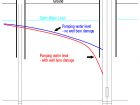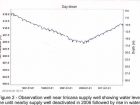
Features
Research
Water Quality
Observation wells 101
Why, where, how and when they should be installed
April 26, 2016 By Ken Hugo
On occasion water well drillers are asked to install an observation well alongside a pumping well. The reason for this is to obtain water levels in a well that are not influenced by having a pump in the well.
Observation wells can be used through the life of the project, not just at the time of the initial aquifer investigation.
Let’s look at just what information we get from observation wells and what they can determine.
Better defined aquifer parameters
From a pumping test one can determine three parameters: the available head in the aquifer, the transmissivity of the aquifer and the storativity. The available head is the distance between the static water level and a suitable lowermost pumping level. The transmissivity is related to the permeability of the rock and such water characteristics as viscosity and density. Both of the parameters can more or less be determined using a pumping well alone.
The last parameter, the storativity, is related to the compression of the water and the rock (in a confined aquifer). There is too much turbulence in a pumping well for this parameter to be accurately calculated: for this an observation well is needed.
Effects of well bore losses
Restrictions around a well bore, either due to inefficient perforations or formation damage during drilling, can lead to additional drawdown of water levels in the well, a situation as shown in Figure 1. Usually a long enough pumping test, or step test, can be done to show the effects of this well bore skin. However, more accurate determination of this feature is much more readily undertaken if observation well data is present.
Extent and influences of boundaries
Sometimes an aquifer boundary may be present and one wishes to see how this boundary influences the well productivity. A boundary may either be a recharge boundary, such as a river or lake, or an impermeable boundary, such as the end of the aquifer. Placing the observation well between the pumping well and the boundary can help you determine if the boundary has an effect on long-term well yield.
Water levels in the aquifer
Frequently concerns are expressed that the aquifer is drying up, or one wishes to know if there is any evidence of aquifer recharge. Water levels in observation wells are well placed to study this because they are not subject to extreme fluctuation in water levels such as are seen in pumping wells.
These observation wells may measure regional aquifer levels or may be placed between one owner’s production well and another owner’s if one owner expresses concern about pumping from another source.
Water levels in other aquifers
Observation wells can be used to show that a well is obtaining water from an isolated aquifer, or perhaps that the aquifer is connected to other aquifers or surface water.
Changes in water levels in an observation well that records water levels in different aquifers or that measures changes in the water table can be used to establish if the water supply aquifer is connected to other aquifers or the surface.
Cases of declining well productivity
Wells may lose productivity over time due to bacterial or chemical encrustation and corrosion or a lowering of water levels in the aquifer.
The first is a local issue to be dealt with by the well owner. The second may involve larger considerations.
While these effects can be determined in the pumping well itself (for instance, by shutting in the well and allowing the water level to return to static), operational and logistical considerations – and even legal proof – may be better obtained through data from an observation well.
Investigations in fractured aquifers
Changes in water levels in a fractured aquifer due to pumping are hard to predict using data from the pumping well only. Drawdown may be observed at long distances within the fractures and only short distances in the rock matrix, at least during a short-term pumping test. Placement of several observation wells may give a more accurate realistic determination of where drawdown is occurring.
Initial warning of adverse changes in aquifer quality
Sometimes contamination may not be initially present in an aquifer but a potential for contaminant migration towards a water supply well may exist. Examples would be salt water intrusion in aquifers close to coastal areas, or contamination of aquifers near industrial sources. An observation well, where samples can be collected, may be used to provide warning of future problems with the water supply and allow corrective actions to be taken before contaminated water is pumped into a distribution system.
Design features
A number of design features should also be taken into consideration when constructing an observation well. The well should record the water level in one aquifer only. Multiple aquifer completions complicate what the data is telling us and should be avoided.
Frequently the question is asked, “At what distance should an observation well be placed from a producing well?” Unfortunately there is no simple answer to that. The ideal distance depends on the time of the pumping test, and the aquifer transmissivity and storativity. As the point of the pumping test is to determine the last two parameters, it is difficult to determine in advance the ideal placement.
To estimate where an observation well should be placed, the aquifer parameters may be estimated and rough calculations can be done. The observation well should be placed outside of the zone of damage and non-laminar flow around the pumping well, so a minimum distance of around 5 m should be observed. A recommended maximum distance for a pumping test project would probably be on the order of 100-150 m.
An observation well placed close to a pumping well may be useful in defining aquifer parameters and evaluating the well bore losses but less useful in determining the regional water levels. Observation wells to determine regional aquifer levels should be placed as far as possible from any large supply well.
One should inquire into other reasons to place an observation well such as if a boundary or potential source of contamination is to be investigated or if the observation well should be placed between two supply wells (or as far away as possible from a secondary supply well).
What diameter should observation wells be? With water level meters and modern transducers, an observation well can have a diameter as little as 2.54 cm (one inch). However, if one wishes to obtain a water sample from an observation well, a minimum diameter of 5.08 cm (two inches) is recommended. Due to availability of supplies and drilling methods, observation wells with standard domestic well diameters are often installed, which is fine. An observation well may be used as a back-up supply well, in which case the diameter may be the same as the main supply well.
Observation wells, like other wells, can get plugged by biological or chemical encrustation. An occasional check on an observation well to make sure the screen is not plugged may be advisable to confirm the accuracy of the readings. This can be done by way of a short pumping test.
Lastly, it is sometimes found that when a new supply well is to be installed, an existing unused well is at the site. Frequently the old well is not ideal as an observation well due to the distance to the supply well, because the old well obtains water from a different aquifer or from multiple aquifers, or even because no data is available on the old well construction details.
Nevertheless, with modern transducers the added cost and effort to measure water levels in an unused nearby well is often minimal. Handheld GPS devices are accurate enough to determine distances between two wells quickly and cheaply. Examination of the data from the old well may provide some information that justifies the small additional cost to collect the data.
Ken Hugo is a technical director and hyrdogeologist with Groundwater Information Technologies (GRIT).
Print this page

